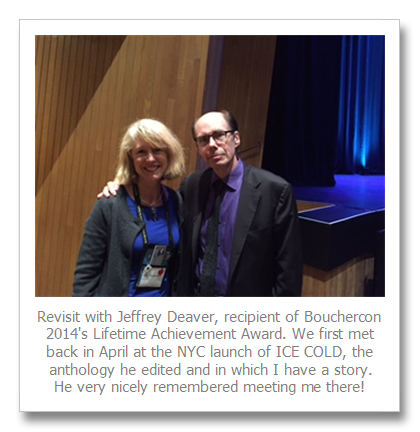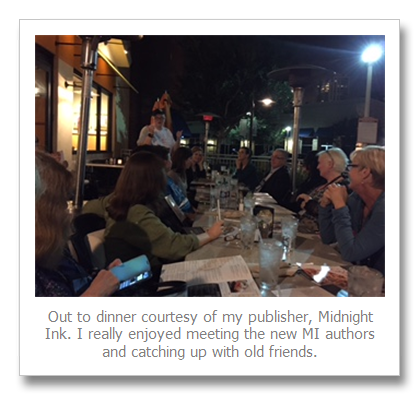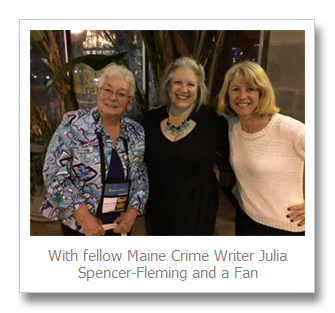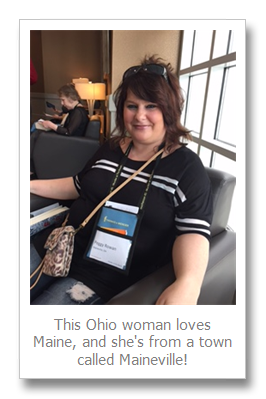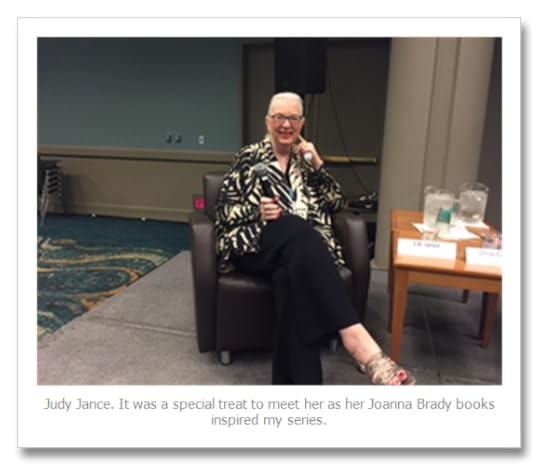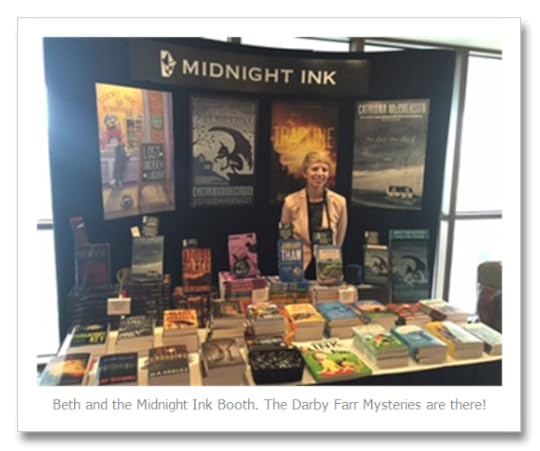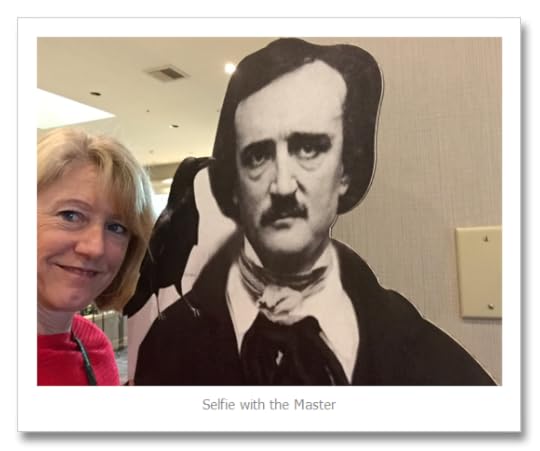Lea Wait's Blog, page 305
November 24, 2014
When Inspiration Fails
Dorothy Cannell: Occasionally, as in now having just finished a book, I feel squeezed dry of

Where Dorothy was until recently….
syllables, let alone even short words. I wilt under the weight of admitting that writing is a job, that my nasty employer (self) heaps on the guilt when I don’t show up for work on a fairly regular basis, take too many coffee breaks, or sneak off to read someone else’s book. I tell myself I’d be much happier returning to the days of telling myself stories. Those that don’t have to be good enough for anyone else, and best of all require no punctuation – major weak spot. Make my head my office. How organized is that?
I start where I always did. Playing the game with which I entertained myself endlessly as a child – ‘What Character Would I Want To Be In A Book?’ Today as I meandered about the house doing comfortably everyday things, including making cranberry sauce … and not much else, I chose one of my longtime favorites – The Vicar’s Wife. Always a nod to the one in Murder at the Vicarage, which was the first mystery I read. She was vividly there on the page of my mind. A pretty, spirited young woman sadly deficient in domestic skills married to a considerably older man whose absent minded reserve prevents him from letting her know until the final chapter that he finds her entrancing.

Who knew inspiration could be found in cranberry sauce?
In Agatha Christie’s novel, the vicar’s husband was named Len. But I decided my character would prefer one with a more romantic name. I toyed with Adrian before settling on Aiden, which seemed to demand that in addition to being exceedingly clever, with an emphasis on the classics, he should also be handsome. For a brief moment he was dark and lean jawed, but that didn’t seem right and he became fair haired with a square jaw. But with dark eyebrows to emphasize the occasional sardonic look he would give his wife in the interest of creating tension between them during the time when they didn’t understand each other’s motivations.
The agreement had been a marriage in name only. Separate bedrooms. He thinking she’d only married him because of a broken engagement following her being left penniless on the death of the maiden aunt who had brought her up. She believing him in love with the squire’s brittle, sophisticated wife. And in the midst of these uncertainties the flurry of vicious anonymous letters arriving at homes through out the parish, the attempted suicide of the churchwarden, the writings of The first Bishop of Tete on Pyke stolen from their hiding place in the bell tower…
That was when I dropped the cranberry sauce stained wooden spoon on the floor, because it had happened as it always did. From conjuring up one character I had shifted into coming up with the straggles of a plot. A dated one. Not the sort much written about today, but considering the book I’ve just finished is set in 1932, this was appealing. Sufficiently so to make me want to get to work – scribble it down. And now I have.
Happy Thanksgiving,
Dorothy
Less Is Sometimes A Whole Lot More by Al Lamanda
Thanksgiving is upon us, and to be honest, I’m pretty sick and tired of hearing about it. Not because I’m not grateful for the many blessings bestowed upon me, my family and our great country, but because I’m not looking forward to eating turkey for the next week to ten days. Yeah, I know, you too. So this little rambling of mine will have nothing to do with Thanksgiving, and I won’t mention it again, although I will share my favorite recipe for turkey with you a bit later. I’m sure you’ve seen it before, but it’s worth repeating.
Instead, I’d like to touch upon my neighbor, an eighty-five-year-old, retired history professor that I call the leprechaun. I call him that because he very much resembles the little guy on the cereal box, you know the one. More importantly, he acts like the little guy on the cereal box. For my neighbor, sitting still is not an option. He fidgets constantly and most days he does so at my house. As a retired, history professor, the leprechaun holds fiction and those of us who write fiction with total disregard as if we were something the dog left for us to pick up in the backyard. He also takes every opportunity to remind me of his valued opinion whenever he can, which is almost every day.
So a week or so before (fill in the blank) day (hey, I said I wouldn’t mention it, right) the leprechaun dances his way over to my house and let’s himself in (because I can’t possibly be busy, right?) I see that you are penning more of your babblement, he said when he saw I was at my desk. (Yes, he really does talk like that) If you mean I am busy writing, then yes, I am busy, I told him. History and non-fiction is the only way to go if you wish longinquity, he advised. What I wished for was for the Leprechaun to kindly go away so I could resume writing, but he insisted on staying and emptying the candy dish.
He took a seat on the sofa, clicked on the television and grabbed a handful of mini Snickers bars from the candy dish. I tried to do a little writing, but the background noise of the television and the munching of mini Snickers distracted me. (Leprechauns are loud eaters, you see) When the Leprechaun tore himself away from the sofa to grab a soda from the fridge, he noticed me staring at my fingers and said, You are most tardigradous.
Not always, I said. Allow me to uptrain you, he said.
I would if I knew what you were talking about, I said. The Leprechaun grabbed a few more mini Snickers and stood over my shoulder. Don’t maffle and tell me what the problem is, he said. Okay, I’m stuck on how to catch the bad guy, I said.
The illaqueation? he said.
I stared at him.
Of the rakeshame, the Leprechaun said.
Umm, sure, I said.
Continue on the path of fiction and you shall always remain a nuncupatory, he said.
Okay, I said and returned to work as the Leprechaun returned to my sofa. A little while later, when the candy dish was empty, the Leprechaun decided to return to his pot of gold and left me alone. His parting words were, I leave you to your wranglesome thoughts.
My only thoughts at that moment were, thank God you’re gone, and do I have anymore mini Snickers? What my Leprechaun of a neighbor doesn’t understand is the beauty of the English language and when to keep it simple. Many young writers I talk to don’t seem to understand this as well. They overcomplicate their work and use words you would need a translator to explain. Hemingway understood the simplicity of words only too well, and his writing style has often been described as economical and understated. Yet, his simple approach to writing won him a Pulitzer and Nobel Prize. Another example of KISS writing is the great Elmore Leonard, who said Hemingway was his single most important influence.
Get the idea?
So when young writers ask me for advice, I tell them KISS. Don’t use words that are difficult to understand. If you want to describe the bad guy as a bad guy, forget rakeshame and call him the bad guy. If something tastes sweet, call it sweet and not saccharinely. If something tastes bitter, call it bitter and not astringent. You won’t need a dictionary to figure out what you want to say, and neither will your readers.
Your story and writing will flow easier if it doesn’t read like a collegiate spelling bee. Sometimes it really is just that KISS.
And now for the above mentioned: my favorite recipe for turkey.
1. Buy a turkey.
2. Have a glass of wine.
3. Stuff turkey.
3. Have a glass of wine.
5. Put turkey in oven.
6. Relax a while with another glass of wine.
7. Turn the bastey.
8. Wine of glass another get.
9. Meat for thermometer hunt.
10. Glass yourself another pour of wine.
11. Bake the wine for four hours.
12. Remove the oven from the turkey.
13. Tet the stable.
14. Grab another wottle of bine.
15. Turk the carvey.
16. Have asouter bass of bine.
17. Pass out in gravy boat and awaken when it’s all over.
Al Lamanda is the author of the Edgar Award nominated mystery novel Sunset. The sequel Sunrise won the Maine Writers and Publishers Alliance award for best crime novel of 2013. His latest mystery First Light is available in stores everywhere and on line.
November 22, 2014
Weekend Update: November 22-23, 2014
 Ne xt week at Maine Crime Writers there will be posts by Al Lamanda (Monday), Dorothy Cannell (Tuesday), Lea Wait (Wednesday), and Barb Ross (Friday) and next weekend we’ll have a special post from our cyber expert, Jayne Hitchcock on what to watch out for during the holiday shopping season.
Ne xt week at Maine Crime Writers there will be posts by Al Lamanda (Monday), Dorothy Cannell (Tuesday), Lea Wait (Wednesday), and Barb Ross (Friday) and next weekend we’ll have a special post from our cyber expert, Jayne Hitchcock on what to watch out for during the holiday shopping season.
In the news department, here’s what’s happening with some of us who blog regularly at Maine Crime Writers:
Lea Wait: This weekend I’ll be signing at Studio 53, (53 Townsend Avenue in Boothbay Harbor, Maine) a wonderful 3-story gallery full of locally-made crafts, jewelry, paintings — and books! I’ll be there Saturday the 22 from 7 a.m. until 11 a.m. (Early Bird Sale in town!) and Sunday from 1 until 2 p.m. Then, next Friday, I’ll be at another wonderful place with Christmas ideas — the Nobleboro Antiques Exchange, route 1 in Nobleboro, Maine, where antiques are displayed, and “repurposing” is the key. Two great places for one-of-a-kind gifts! ![51qkuGEqAxL._AA160_[1]](https://i.gr-assets.com/images/S/compressed.photo.goodreads.com/hostedimages/1416107032i/11891220.jpg)
And I’ll really thrilled that the towns of Rumford, Mexico, Dixfield, Byron, Hanover, Roxbury, Carthage and Canton (yes, they’re all in Maine!) have chosen UNCERTAIN GLORY as a community read for this spring as part of their project “Local & Legendary: Maine in the Civil War.” I look forward to visiting with those folks next spring.
Kaitlyn Dunnett/Kathy Lynn Emerson: No news from me, but I’m chiming in to comment on Lea’s community read. Those towns are by way of being neighbors. In fact, I can see the Wilton/Carthage town line from my house. By the time of Lea’s visit, the new windmills up on the ridge will probably be operational.
An invitation to readers of this blog: Do you have news relating to Maine, Crime, or Writing? We’d love to hear from you. Just comment below to share. Don’t forget that comments are entered for a chance to win our wonderful basket of books and the very special moose and lobster cookie cutters.
And a reminder: If your library, school, or organization is looking for a speaker, we are often available to talk about the writing process, research, where we get our ideas, and other mysteries of the business. Contact Kate Flora: mailto: kateflora@gmail.com
November 21, 2014
Back from Bouchercon
Vicki Doudera here, and I’m back from Long Beach, California and my first Bouchercon. For those of you who are wondering what the heck I’m talking about, Bouchercon is the World Mystery Convention, held annually in the fall for writers and fans. The first one took place in 1970 in Santa Monica, California, and recent ones have been held in Cincinnati, Albany, Anchorage, and St. Louis.
Bouchercon is named for Anthony Boucher, a writer, editor, and critic of science fiction and mystery.According to the convention’s website, Boucher “championed many crime-writing greats long before the mainstream literary establishment recognized their talents, and remained an indefatigable fan and insightful reviewer of every category of crime fiction. He helped found Mystery Writers of America in 1946 and served as its president in 1951”
Bouchercon has grown over the years to be a giant gathering, and, speaking as a first-timer, it’s somewhat overwhelming. But I had a wonderful time, met up with old writing buddies, connected with some readers and made many new friends. What more could a crime writer ask for?
November 19, 2014
How Much Danger is Too Much?
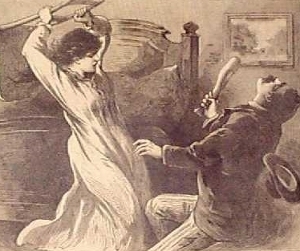 Kaitlyn Dunnett here. I recently had an interesting email exchange with a reader in Australia. Although she likes the Liss MacCrimmon mysteries, she feels I tend to put Liss in too much danger at the end of the books. She pointed out, as our correspondence continued, that Miss Marple and Miss Silver are rarely in danger. They discover the identity of the murderer but don’t risk their lives to do so. Then she commented that putting the sleuth in danger makes it seem that the author doesn’t have enough faith in the interest and excitement of the story as it stands and has up the ante at the end to keep the reader’s attention.
Kaitlyn Dunnett here. I recently had an interesting email exchange with a reader in Australia. Although she likes the Liss MacCrimmon mysteries, she feels I tend to put Liss in too much danger at the end of the books. She pointed out, as our correspondence continued, that Miss Marple and Miss Silver are rarely in danger. They discover the identity of the murderer but don’t risk their lives to do so. Then she commented that putting the sleuth in danger makes it seem that the author doesn’t have enough faith in the interest and excitement of the story as it stands and has up the ante at the end to keep the reader’s attention.
Wow. Food for thought.
I responded that I felt most of my readers expect Liss to be in jeopardy before the villain is captured. If Liss is going to investigate a murder, she’s going to make an enemy of the murderer, who is trying to get away with his or her crime. That makes Liss a target. If she simply turns the information she finds over to the police and lets them make an arrest, the end of the book ending will seem anticlimactic.
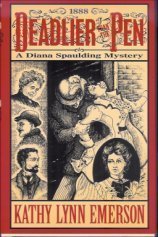 The last chapters of my mysteries aren’t particularly violent. The most harm I’ve ever done to Liss is in Vampires, Bones, and Treacle Scones and even there she suffers no long-term damage. I wouldn’t consider the level of violence either excessive or gratuitous. But put my heroine in danger at the end of a book? Yes, I definitely do that, and deliberately, too. That applies to the historical mysteries I write as Kathy Lynn Emerson as well as to the Liss MacCrimmon series. To tell you the truth, I think I’ve always considered doing so to be a requirement of the mystery genre, whether we’re talking cozy or hard-boiled or police procedural. In fact, the covers of my Diana Spaulding 1888 Quartet all reflect this by picturing an “action” scene, although not necessarily one at the climax of the story. It’s the degree of danger and violence that differs from one sort of book to another. So, the question remains: how much danger is too much in a cozy?
The last chapters of my mysteries aren’t particularly violent. The most harm I’ve ever done to Liss is in Vampires, Bones, and Treacle Scones and even there she suffers no long-term damage. I wouldn’t consider the level of violence either excessive or gratuitous. But put my heroine in danger at the end of a book? Yes, I definitely do that, and deliberately, too. That applies to the historical mysteries I write as Kathy Lynn Emerson as well as to the Liss MacCrimmon series. To tell you the truth, I think I’ve always considered doing so to be a requirement of the mystery genre, whether we’re talking cozy or hard-boiled or police procedural. In fact, the covers of my Diana Spaulding 1888 Quartet all reflect this by picturing an “action” scene, although not necessarily one at the climax of the story. It’s the degree of danger and violence that differs from one sort of book to another. So, the question remains: how much danger is too much in a cozy?
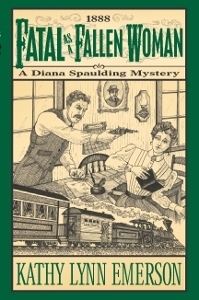 I don’t see myself doing without a confrontation scene between amateur sleuth and villain in which the villain temporarily holds the upper hand. For one thing, without it, it is difficult to have what syndicated columnist Joel Achenback dubbed “the obligatory spilling of the beans” at the end of the novel. As Achenback put it, this is “where the villain explains his diabolical plot to rule the world, a moment of braggadocio that will lead to his downfall once the hero escapes.” This won’t happen unless the villain plans to kill his or her listener right after confessing. I grant you that this isn’t the only way to manage explanations and tie up loose ends at the end of a mystery novel, but it is one tried and true device that ups both the stakes and the suspense. Of course we know Liss (or Diana or Susanna or Rosamond) will find a way to survive or the book wouldn’t be part of a cozy series.
I don’t see myself doing without a confrontation scene between amateur sleuth and villain in which the villain temporarily holds the upper hand. For one thing, without it, it is difficult to have what syndicated columnist Joel Achenback dubbed “the obligatory spilling of the beans” at the end of the novel. As Achenback put it, this is “where the villain explains his diabolical plot to rule the world, a moment of braggadocio that will lead to his downfall once the hero escapes.” This won’t happen unless the villain plans to kill his or her listener right after confessing. I grant you that this isn’t the only way to manage explanations and tie up loose ends at the end of a mystery novel, but it is one tried and true device that ups both the stakes and the suspense. Of course we know Liss (or Diana or Susanna or Rosamond) will find a way to survive or the book wouldn’t be part of a cozy series.
Our email discussion also explored the acceptability of more violent endings when that violence is in keeping with the book as a whole. My correspondent found the endings of my books a bit more frightening than the rest of the stories warranted. This is a valid criticism and I’m going to have to take a hard look at this aspect of things at as I write the next one. Then she added yet another thought-provoking comment: my cliff-hanger endings arise out of the character of the heroine because Liss is “a bit too defensively sure of her own abilities on feminist grounds.”
I don’t think of Liss as a feminist, but I do write her as self-confident (except around her domineering mother), sometimes foolishly so. And she’s impulsive—her main character flaw. In the old days, there was a category called the “women in jeopardy” novel. It morphed into “romantic suspense” and along the way the kick-ass heroine emerged, a woman capable of getting herself out of danger. Sometimes she ended up saving her significant other, too. In these novels there is always a scene toward the end of the book where everything, even the heroine’s life, is at risk. I have trouble imagining writing a story without that climactic moment when the heroine defies the odds to thwart the bad guy.
 But the question of how much danger is too much in a cozy mystery remains. In the most recent Liss MacCrimmon, Ho-Ho-Homicide, written well before this email exchange, Liss is definitely in danger of losing her life and she definitely experiences physical violence. I write about her fear but skip fairly delicately over her pain. I don’t want to read scenes with graphic violence, let alone write them. In next year’s entry, The Scottie Barked at Midnight, also turned in before this subject came up, Liss is again in danger, although this time it comes earlier in the book and it is not a threat of being stabbed, shot, or throttled. Instead, she ends up on her own in the middle of nowhere and is at risk of developing hypothermia if she can’t find her way back to civilization. Is she ever truly in danger of losing her life? Well, she certainly thinks she is. And that’s all I can say about it without spoilers.
But the question of how much danger is too much in a cozy mystery remains. In the most recent Liss MacCrimmon, Ho-Ho-Homicide, written well before this email exchange, Liss is definitely in danger of losing her life and she definitely experiences physical violence. I write about her fear but skip fairly delicately over her pain. I don’t want to read scenes with graphic violence, let alone write them. In next year’s entry, The Scottie Barked at Midnight, also turned in before this subject came up, Liss is again in danger, although this time it comes earlier in the book and it is not a threat of being stabbed, shot, or throttled. Instead, she ends up on her own in the middle of nowhere and is at risk of developing hypothermia if she can’t find her way back to civilization. Is she ever truly in danger of losing her life? Well, she certainly thinks she is. And that’s all I can say about it without spoilers.
I’m very glad one of my readers took the time to make her feelings known. Every once in a while it is good for writers to step back and take a long, hard look at why they structure their stories the way they do. Most of the cozies and traditional mysteries I read put the sleuth in some sort of danger at the end of the novel, but there are ways to maintain suspense and up the ante without doing so. As I start work on the tenth Liss MacCrimmon novel, I’m going to be considering all the possibilities.
November 18, 2014
A question of morale
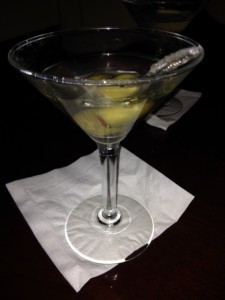
Sometimes one is so tempted to take to drink
Kate Flora, here: A Maine writer attending the New England Crime Bake conference a week ago observed that she appreciated what we are writing at Maine Crime Writers because there is often useful advice for other writers. Since one of the goals of the Crime Bake is to create community among crime writers, her remark reminded me of this old column I wrote about writer’s block and keeping up our spirits when our publishing goals always seem too far away and what we’re writing feels like gravel.
We’re coming into the dark season now, and when the days are short and the weather gets nasty, it’s hard to keep our spirits up. So here are some thoughts as we all embark on winter.
Everything I write lately does feel like gravel and as I’m embarking on a new Joe Burgess book, it seems like I have no new or fresh ideas. After a chat with my artist friend, Pete, about how my spirits won’t lift and I’m getting very little writing done, I decided to look up writers and morale on the internet, and see what wisdom was out there. My first hit immediately lifted my spirits. I found this, from the UVic student writing guide:
As a noun, a moral is what you get at the end of a fairy tale.
As an adjective, moral means “righteous” or “ethical.” It is an example of an abstract word which can be abused.
Morale measures the level of your spiritual happiness, usually when you are at war or playing sports.
When I stopped smiling, I started to wonder: when I am writing, and my “spiritual happiness” seems to be a low ebb, it this war or sports? Some days it sure feels like war, like a perpetual battle of the writer against the editor, the agent, the bookseller, the other writers whose books are being chosen or purchased or lauded, and the tiresome postman who keeps bringing bad news or no news and rarely a check.
Other days, it seems like a sport, especially when I’ve scored a goal, or the equivalent of a goal in the writer’s arena of worldly success. Those goals are hard won, though, and they don’t come very often. The fact is that this is a hard business. Not as hard as being a cop or an emergency room physician, but hard. To get the work done, we must be solitary for long periods of time, and we have to be our own bosses. We are the ones who have to set our own schedules, keep ourselves in our chairs, and meet our deadlines. Often, we even have to create our own deadlines.
Sometimes, the rewards seem too fleeting compared to the time we spend working toward them. And for the aspiring writer, the beginner, there is often little more than faith in their own ability to sustain them. I’ve been sitting here today thinking about some of the writers I know who have struggled for years to achieve publication. Some of them, some really talented writers, have finally gotten discouraged and given up.
When I hear that another writer is feeling despair, I always wish I had more wisdom, after thirty years at

We try to be wise, but is anyone listening?
this, to share. More time and generosity to sit and listen, to pay attention, to notice when people I care about are looking pinched and broken. And I wonder if other writers have better answers to the question: What should we be doing for each other? How can we help each other remember that we’re writers because we love words, and using our imaginations, and telling stories. And that we don’t stop being writers because someone didn’t love our latest story or we got a rejection letter in the mail, or something we thought was done needs to be rewritten.
As I’ve said all along–if you want to be a writer, you have to have the hide of an alligator. And you have to believe in yourself because no one else cares as much as you do. You have to believe in your right to write. You have to protect your writing time for everything that would steal it. You have to find your joy in the relationship between your mind and the page. In the now and now instead of what may lie ahead.
My friend Pete closed the conversation by suggesting that when it’s all discouraging, he seeks renewed inspiration by going to a museum and looking at paintings by great artists. Maybe, he suggests, I should read a really good book. And I happen to have one right here. So when my Blogging “homework” is done, I’m going to reread Roxana Robinson’s Sparta, and study her storytelling and how she reveals her characters. And tomorrow, I know, will be better.
Something else I found while I was looking up writers and morale. On a site called Geist.com, I found a writing exercise labeled: Morale Exercise: Real Writers . . .
So next time you have a discouraged day, write this down: “Real writers …” and free write from this for 10 minutes.
 Real writers drink bourbon, believe in rewrite, and try to use words more creative than those labeled by my mother as “ordinary swears.” This sometimes leads to some peculiar questions, as I try to improve my vocabulary. Real writers watch the world around them and wonder about it. Real writers listen in on other people’s conversations and pay attention. Real writers blow off the laundry and eat cold pizza because their characters are doing things they need to attend to. Real writers are willing to admit, even when they’re stuck in the unpublished writer’s corner, that they are writers, because on the good days, being a real writer is magical.
Real writers drink bourbon, believe in rewrite, and try to use words more creative than those labeled by my mother as “ordinary swears.” This sometimes leads to some peculiar questions, as I try to improve my vocabulary. Real writers watch the world around them and wonder about it. Real writers listen in on other people’s conversations and pay attention. Real writers blow off the laundry and eat cold pizza because their characters are doing things they need to attend to. Real writers are willing to admit, even when they’re stuck in the unpublished writer’s corner, that they are writers, because on the good days, being a real writer is magical.
Well, gentle reader, who knows where this exercise will put you ten minutes later? Thanks for listening.
November 17, 2014
A Change of Plan
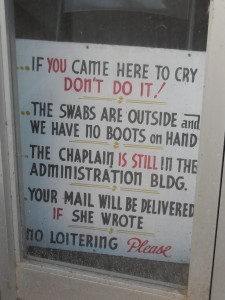 Hello again from Sarah Graves, who has planned for traveling but has not been doing so. For instance: The 2014 Crime Bake in Dedham, Massachusetts was great, I hear. I was supposed to learn this in person, but with my bags packed, registration long accomplished, banquet ticket bought and bus fare in hand, I was instead felled by a virus of unknown origin pretty much as I walked out my back door. While I might’ve attempted the trip anyway, I made the on-the-spot judgment call that maybe a 6-hour bus ride was not such a good idea under the circumstances. So I pouted instead, which turned out to be just about all I could accomplish for the next 48 hours, and I’m still disappointed. I do, however, have a virtuous feeling about all the people I did not infect with an ailment whose intensity was matched only by its unpleasantness. You’re welcome, everyone.
Hello again from Sarah Graves, who has planned for traveling but has not been doing so. For instance: The 2014 Crime Bake in Dedham, Massachusetts was great, I hear. I was supposed to learn this in person, but with my bags packed, registration long accomplished, banquet ticket bought and bus fare in hand, I was instead felled by a virus of unknown origin pretty much as I walked out my back door. While I might’ve attempted the trip anyway, I made the on-the-spot judgment call that maybe a 6-hour bus ride was not such a good idea under the circumstances. So I pouted instead, which turned out to be just about all I could accomplish for the next 48 hours, and I’m still disappointed. I do, however, have a virtuous feeling about all the people I did not infect with an ailment whose intensity was matched only by its unpleasantness. You’re welcome, everyone.
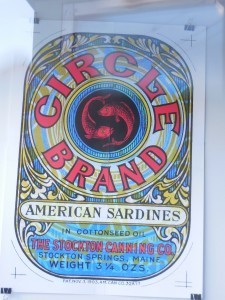 This is a print of a sardine label, from back when people ate sardine sandwiches for lunch. I personally can’t even look at an anchovy. Popping a whole fish of any size into my mouth — and then, dear heaven, chewing it! and swallowing it! — just isn’t in my DNA, it seems. But at one time those sandwiches were as common as PB&J is now, and plenty of people on the Maine coast made their living by catching, cutting, and packing the small fish into tins, and labeling them like the one at right. Here in Eastport there were several “sardine factories” where mostly women (and children, wielding knives as long as their arms and standing on boxes to reach the cutting tables) prepped and packed the catch. Different factories had different whistles, so that wherever you were in town you knew when “your” factory’s load of sardines had come in, and you should hurry down to work.
This is a print of a sardine label, from back when people ate sardine sandwiches for lunch. I personally can’t even look at an anchovy. Popping a whole fish of any size into my mouth — and then, dear heaven, chewing it! and swallowing it! — just isn’t in my DNA, it seems. But at one time those sandwiches were as common as PB&J is now, and plenty of people on the Maine coast made their living by catching, cutting, and packing the small fish into tins, and labeling them like the one at right. Here in Eastport there were several “sardine factories” where mostly women (and children, wielding knives as long as their arms and standing on boxes to reach the cutting tables) prepped and packed the catch. Different factories had different whistles, so that wherever you were in town you knew when “your” factory’s load of sardines had come in, and you should hurry down to work.
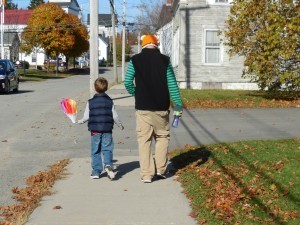 It’s cold here now, but last week we were still enjoying the fool’s gold of early November. Leaves were raked and newly planted garlic beds were covered with straw while we asked one another if maybe it wasn’t too soon, because if it stayed this warm for much longer the bulbs would sprout early. We put the straw down anyway, though, because in our hearts we recognized what none of us wanted to admit, and now we’re nodding sagely at one another: we knew it all along.
It’s cold here now, but last week we were still enjoying the fool’s gold of early November. Leaves were raked and newly planted garlic beds were covered with straw while we asked one another if maybe it wasn’t too soon, because if it stayed this warm for much longer the bulbs would sprout early. We put the straw down anyway, though, because in our hearts we recognized what none of us wanted to admit, and now we’re nodding sagely at one another: we knew it all along.
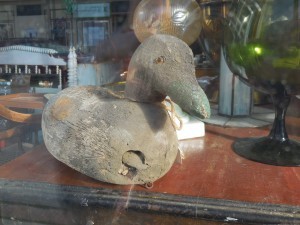 I see these decoys in antique stores and think of the ones that used to be in our basement when I was a kid. There were big burlap bags full of them, all glass-eyed and painted to resemble the birds that flew in by the thousands to Horicon Marsh in northern Wisconsin. Near the bags stood the huge hand-built table with the shotgun-shell reloading press bolted to it. On the bench too were the bags of shot, the gun powder, the wadding disks and small bright metal primers. Often there were bags full of spent shells there, as well, and on Sunday afternoons we kids went down and reloaded shotgun shells for fun. I can still feel the heavy, solid ka-chunk! of the shell press coming down to mash all the contents together and crimp the end tightly closed. (I can still feel my tooth coming down on a stray bit of birdshot when we ate roasted duck, too, but that’s another story.)
I see these decoys in antique stores and think of the ones that used to be in our basement when I was a kid. There were big burlap bags full of them, all glass-eyed and painted to resemble the birds that flew in by the thousands to Horicon Marsh in northern Wisconsin. Near the bags stood the huge hand-built table with the shotgun-shell reloading press bolted to it. On the bench too were the bags of shot, the gun powder, the wadding disks and small bright metal primers. Often there were bags full of spent shells there, as well, and on Sunday afternoons we kids went down and reloaded shotgun shells for fun. I can still feel the heavy, solid ka-chunk! of the shell press coming down to mash all the contents together and crimp the end tightly closed. (I can still feel my tooth coming down on a stray bit of birdshot when we ate roasted duck, too, but that’s another story.)
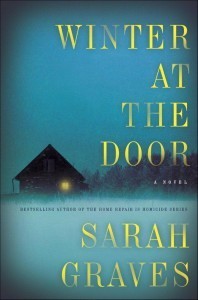 One plan that has not changed is for WINTER AT THE DOOR, still due out January 6, 2015. I distinctly recall writing the first few words of this, feeling that stepping-off-into-the-void sensation of starting a novel, knowing there were 89,995 words of it left to write and that I had no idea what any of them were. I mention this now because, had I been at Crime Bake and had anyone asked me, I’d have said it’s the same whether it’s your first book or your many-eth: there is really nothing else you can do but go on. Page one is as blank for the old writer as for the new, the words as unknown until they’re written. Fortunately, the only thing you can do — keep at it — is also the main (some say only) requirement, when you get right down to it.
One plan that has not changed is for WINTER AT THE DOOR, still due out January 6, 2015. I distinctly recall writing the first few words of this, feeling that stepping-off-into-the-void sensation of starting a novel, knowing there were 89,995 words of it left to write and that I had no idea what any of them were. I mention this now because, had I been at Crime Bake and had anyone asked me, I’d have said it’s the same whether it’s your first book or your many-eth: there is really nothing else you can do but go on. Page one is as blank for the old writer as for the new, the words as unknown until they’re written. Fortunately, the only thing you can do — keep at it — is also the main (some say only) requirement, when you get right down to it.
November 16, 2014
The Death of Local News, or if you want to get away with murder, come to Hartland.
As time goes by, I miss writing for the Sebasticook Valley Weekly more and more. It was a local weekly published in Newport and my first encounter with it was when Brenda Seekins, the editor, stopped by the library and asked if we’d like some copies. I said we certainly would and was she interested in a weekly library column. She was, and in short order, I was back to doing what I still believe is the best marketing tool a public library can have, writing a weekly newspaper column touting the things happening at the library as well as teasing potential borrowers with brief descriptions of new additions to the collection.
I knew from my five years of writing a similar column for The Boothbay Register while I was library director there, that plenty of people would read a few columns, develop a sense of comfort and familiarity with the library by doing so and then come in to get a card. It worked just as well in Hartland. It wasn’t long before I expanded my writing for the SV Weekly by doing an irregular feature called “Getting to Know Your Neighbors.” I’d spend an hour or so interviewing someone who I knew had an interesting background and then write it up with a photo or two. Over the course of a year or two, I met and profiled a local musician who was inducted into the Maine Country Music Hall of Fame, a true renaissance man who calibrated Norden Bombsights during World War 2 and interviewed the widow of a man whose demise was directly related to wild turkey poop.
At some point, I realized that almost every weekly columnist in the paper was far to the right, so far in fact, that reading an issue made my teeth hurt. When I asked the new editor (Brenda had moved on) when he was going to have a liberal columnist, his response was right to the point. “When are you going to start writing it?” I spent the following morning weeding our raised bed flower garden while running ideas for columns through my head. That afternoon, I sat down and started putting a few on paper and my second regular entry in the newspaper, “Right-Minded, But Left of Center,” was born. I can say with absolute certainty that writing it cost me some library patrons, but it also made me some new friends and was read by plenty of people in an area from Skowhegan to Milo. Heck, it was great fun to tweak the right wing on a weekly basis. Unfortunately, the paper folded, and after trying to write for a diminished web version that was focused on Lincoln and the surrounding towns, I dropped it.
Sadly, Hartland seems to exist in a news vacuum these days. Neither the Waterville Sentinel nor The Bangor Daily News consider us of importance. Consider the following events, all of them true or easily provable. A few months back, a young woman was walking home after visiting her sister. The specifics are cloudy and there are details I’m not at liberty to disclose, but the upshot is that she was run over around 11 at night in front of the fire station. The driver stopped, but immediately sped off. She suffered nine broken ribs and a busted collerbone. Nothing appeared in the newspaper and to this day, no one has been arrested or charged.
Last month, the siren at the tannery started wailing and before anyone knew what was happening, fire trucks from as far away as Skowhegan rushed into town. There was a brief teaser about a fire at the tannery on the Bangor Daily News website that promised further details. A thorough perusal of both the web and print versions the following morning yielded nothing. The bean hole supper, scheduled for the following evening in Winterport, however, did merit three inches in the State section. I followed up by asking one of my regular patrons who works at the tannery what happened. It seems that the town dodged a bullet. There are two large machines located at the end of the main tannery building which are used to oil and wax hides. The more efficient one was about to be cleaned when there was a major miscommunication. Person A neglected to turn off the heating element and person B started sending a cleaning patch through which ignited. Fortunately there was a sprinkler system which activated automatically, dousing most of the fire while closing a door leading to the adjacent room where the bulk of flammable chemicals are stored. If there had been a malfunction in the sprinklers, it could have been scary, as not only were the chemicals nearby, but newly installed industrial size propane tanks were right outside the building where the machine was located. It’s not out of the realm of possibility that a big part of beautiful downtown Hartland could have been flattened had things not gone as they did. As it stands, the affected machine is out of operation and will probably require specially machined parts to get back in operation. While I think this was definitely newsworthy, the two papers mentioned above did not.
The two teens, aged 13 and 14 who did an estimated $6,000 in damage to the elementary school, the new town pool and a couple houses in town, did merit an article in the Waterville paper, but Bangor ignored them. These little darlings were released to their parents and are free to wander about town, generally without adult supervision.
The as yet unidentified individual who ransacked two cars in a friend’s driveway before going upstairs and ransacking an apartment and then spray painting obscenities on the side of their house while the family was in the living room watching television also failed even a mention in the police log, nor have there been any leads regarding the perps.
We have what even the village idiot can see is a shooting gallery within 500 feet of the elementary school (as I understand it, this should be felony territory), but no arrests have been made. I have another friend who used to go there to get high before he straightened his life out and at least one individual overdosed there.
Finally, there’s the copper theft that wasn’t. This is a real head scratcher. The tannery annex is behind my house and I kept hearing a lot of what sounded like sawing and pounding going on out there. It turns out that someone was cutting and carrying off the copper piping. When they were caught, charges were filed. These had to be dropped when they got to court. Why? Because the building was officially abandoned by whomever got ownership after the current tannery operators decided not to use it any longer. If there’s no owner, there’s no crime. Once again, this eluded the local news establishments as did the fact that some local teens broke in and had one heck of a fight, using the fire extinguishers.
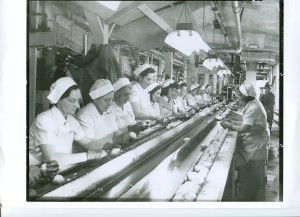
The tannery annex from an earlier time when it was a thriving corn cannery.
So, good people, I’m betting that if you wanted to knock someone off, you couldn’t pick a better town to do it in that Hartland, Maine, the town that news forgot. However, if you do so, please let me know so I can put it in my next short story.
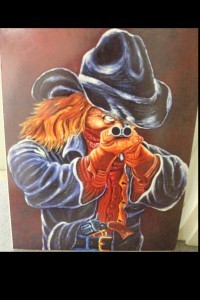
Photo of a painting given to retired game warden John Ford.
November 14, 2014
Weekend Update: November 15-16, 2014
 Next week at Maine Crime Writers there will be posts by John Clark (Monday), Sarah Graves (Tuesday), Kate Flora (Wednesday), Kaitlyn Dunnett (Thursday), and Vicki Doudera (Friday).
Next week at Maine Crime Writers there will be posts by John Clark (Monday), Sarah Graves (Tuesday), Kate Flora (Wednesday), Kaitlyn Dunnett (Thursday), and Vicki Doudera (Friday).
In the news department, here’s what’s happening with some of us who blog regularly at Maine Crime Writers:
Kate Flora: Just got an e-mail from my publisher with this news about Death Dealer:
“Award-Winning Finalist in the “True Crime: Non-Fiction” category of the 2014 USA Best Book Awards” – DEATH DEALER: How Cops and Cadaver Dogs Brought a Killer to Justice (9780882824765) by Kate Clark Flora
And Kate adds this, from Joshua Bodwell at MWPA:
MAINE CALLING BOOK CLUB Don’t forget that Roxana Robinson’s “Sparta”—winner of the 2014 Maine Literary Award for Fiction—is the November pick for MPBN’s Maine Calling Book Club. Read the novel and tune in for the discussion at 12pm on Wednesday, November 26. *As an added bonus, we hear that Kate Flora—winner of the 2013 Maine Literary Award for Crime Fiction—is going to be one of the panelists for the Nov 26 discussion!
http://news.mpbn.net/programs/maine-calling
Finally, at the risk of making this update too Kate-centric, here are two little YouTube videos of me reading from my two new books at my book launch party on Thursday:
https://www.youtube.com/watch?v=8vIQSc-Z7tQ KATE FLORA #09 11/13/14
https://www.youtube.com/watch?v=pq3HSewjnig KATE FLORA #11 11/13/14
Lea Wait: Reading this on Saturday, November 15? Live near the Maine Mall in South Portland,
![51qkuGEqAxL._AA160_[1]](https://i.gr-assets.com/images/S/compressed.photo.goodreads.com/hostedimages/1416107032i/11891220.jpg) Maine? Then com’on over and say hello! I’ll be signing copies of my UNCERTAIN GLORY at the Islandport kiosk from 3:00 until 5:00 this afternoon. Next weekend? I’ll be signing copies of my recent books (including SHADOWS ON A MAINE CHRISTMAS and UNCERTAIN
Maine? Then com’on over and say hello! I’ll be signing copies of my UNCERTAIN GLORY at the Islandport kiosk from 3:00 until 5:00 this afternoon. Next weekend? I’ll be signing copies of my recent books (including SHADOWS ON A MAINE CHRISTMAS and UNCERTAIN  GLORY) at Studio 53, 53 Townsend Avenue, in Boothbay Harbor, Maine from 5-8 Friday night, November 21, from 7-11 Saturday morning (early birds!) and from 1-2 Sunday afternoon the 23rd. Studio 53 also has wonderful art, high end crafts, and jewelry — a great place to start (or end!) your Christmas shopping.
GLORY) at Studio 53, 53 Townsend Avenue, in Boothbay Harbor, Maine from 5-8 Friday night, November 21, from 7-11 Saturday morning (early birds!) and from 1-2 Sunday afternoon the 23rd. Studio 53 also has wonderful art, high end crafts, and jewelry — a great place to start (or end!) your Christmas shopping.
Kaitlyn Dunnett: I’ve just heard from my agent that the title I picked for next year’s Liss MacCrimmon mystery, The Scottie Barked at Midnight, has been approved by the powers that be at Kensington Books. Yea! It will be out in November 2015. To my surprise, it’s already listed at Goodreads, which is where I’ve been concentrating my social media efforts lately. If any of you good folks reading this are also on Goodreads I hope you’ll visit my author pages there. I have one as Kaitlyn Dunnett and another as Kathy Lynn Emerson and both of us are always glad to accept new “friends.” I keep my reading list at Goodreads, for those of you curious about what books I have recently read. Most of the list is on Kathy’s page, but I’m gradually dividing my reading by putting traditional mysteries on Kaitlyn’s booklist while the historical and paranormal novels and the nonfiction stay with Kathy. And yes, sometimes it is confusing having a split personality!!
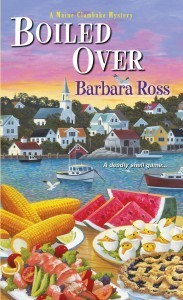 Barb: This week I was thrilled to learn that Boiled Over was nominated for an RT Book Reviews, Reviewer’s Choice Best Book Award–Amateur Sleuth. So pleased! http://www.rtbookreviews.com/award/2014/amateur-sleuth
Barb: This week I was thrilled to learn that Boiled Over was nominated for an RT Book Reviews, Reviewer’s Choice Best Book Award–Amateur Sleuth. So pleased! http://www.rtbookreviews.com/award/2014/amateur-sleuth
Also, it must be title approval week at Kensington, because my editor and I also agreed on the title for the 2016 Maine Clambake book–Fogged Inn!
An invitation to readers of this blog: Do you have news relating to Maine, Crime, or Writing? We’d love to hear from you. Just comment below to share. Don’t forget that comments are entered for a chance to win our wonderful basket of books and the very special moose and lobster cookie cutters.
And a reminder: If your library, school, or organization is looking for a speaker, we are often available to talk about the writing process, research, where we get our ideas, and other mysteries of the business. Contact Kate Flora: mailto: kateflora@gmail.com
November 12, 2014
KILLER THANKSGIVING RECIPES
Susan Vaughan here. Yes, I know Thanksgiving comes later in the month, but sharing these killer Thanksgiving recipes allows time to shop for ingredients.
Thanksgiving is my husband’s favorite holiday—family and friends, great food, but no pressure about gifts—so we have the complete Thanksgiving turkey dinner, no matter it’s just the two of us. Back in the Dark Ages when I grew up, the only cranberry sauce I knew was a tasteless jelly that came in a can (sorry, Ocean Spray). One spoonful and I decided this side to the turkey extravaganza was not for me. As an adult, I shunned even homemade sauce, thinking it would be no better. It wasn’t until I married that I learned to love the real thing. At my in-laws’ home for our first Thanksgiving as a married couple, of course I couldn’t turn down my mother-in-law’s homemade whole-berry cranberry sauce. Yeah, it’s a cliché in novels when an author describes taste as exploding on the tongue, but that was exactly my experience. At last, a cranberry sauce that made my taste buds dance. Every Thanksgiving since, I’ve made her killer recipe and am sharing it with you in her memory. The recipe can be adjusted for different amounts of berries.

Whole-Berry Cranberry Sauce
MRS.VAUGHAN’S CRANBERRY SAUCE
Ingredients: 12 ounces fresh cranberries, 1 ½ cups of water, 1 ½ cups of sugar.
Combine all in a saucepan and heat on stovetop. Stir until sugar is dissolved. Bring to a boil and boil about 20 minutes. Let cool slightly, then pour into a bowl or mold. Chill. The sauce jells nicely and looks pretty, almost too pretty to eat.
Next up is a to-die-for pumpkin pie recipe. It’s a lower-fat version of the classic dessert, but no one ever notices the difference (and I’ve kept the low-fat secret from my husband for years).
LOWER-FAT PUMPKIN PIE
Preheat oven to 425 degrees. Ingredients: 3 eggs or 4 egg whites, 1 can pumpkin, 1 teaspoon cinnamon, ½ teaspoon ginger, ¼ teaspoon nutmeg; 1/8 teaspoon cloves; ½ teaspoon salt, 1 can (14 ounces) Eagle Brand Fat Free Sweetened Condensed Milk, a nine-inch unbaked pie crust.
In a large bowl, beat eggs slightly. Add pumpkin, spices, salt. Beat until well blended. Slowly add the condensed milk and mix well. Pour into pie shell. Bake at 425 degrees for 15 minutes. Reduce oven heat to 350 degrees and continue baking for 25-30 minutes longer, or until a knife comes out clean. Serves 8.
Anyone who would like printable versions of these recipes, email me at shvaughan.author@gmail.com. Put “Thanksgiving recipes” in the Subject line. And Happy Thanksgiving to all!
*** Watch for sales of my Task Force Eagle books, NEVER SURRENDER, ONCE BURNED, and TWICE A TARGET, coming soon on Amazon. You can find more information about my books at www.susanvaughan.com.
Lea Wait's Blog
- Lea Wait's profile
- 509 followers


